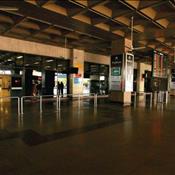
The skies above the Middle East, a critical nexus for global aviation, have once again witnessed significant upheaval. A recent escalation in regional tensions between Israel and Iran has triggered an unprecedented airspace shutdown, directly impacting UAE flights and causing widespread travel disruptions. Major carriers from the United Arab Emirates, including Emirates, Etihad, and flydubai, along with Air Arabia, have been compelled to cancel routes and implement extensive rerouting flights, sending ripples across the aviation industry and leaving thousands of passengers grappling with uncertainty. This detailed article delves into the immediate and long-term consequences of this latest Israel-Iran airspace shutdown, examining the specific flight cancellations, the broader passenger impact, the operational challenges faced by airlines, and the wider economic impact on the region's crucial air travel sector.
The Catalyst: Escalating Regional Tensions and Airspace Closure
The catalyst for the most recent airspace closure was a series of military strikes, notably Israel's "Operation Rising Lion" targeting Iranian nuclear and military facilities on Friday, June 13, 2025. This aggressive action swiftly led to a retaliatory Israel-Iran airspace shutdown by Tehran, followed by similar precautionary measures by neighboring countries. The immediate aftermath saw a rapid domino effect of airspace restrictions across the Middle East airspace, forcing airlines to make swift, critical decisions regarding their airline schedules and flight paths. The safety and security of passengers and crew became the paramount concern, necessitating the unprecedented cancel routes action.
The airspace closure was not confined solely to Iran and Israel. Iraq promptly suspended operations at all its airports, and Jordan, strategically located between Israel and Iraq, also temporarily closed its airspace. This created a vast, no-fly zone, significantly complicating international air traffic and forcing a complete re-evaluation of established long-haul flights between Europe, Asia, and the Gulf. The immediate airspace shutdown on June 13, 2025, marked a critical turning point for airline operations in the region.
UAE Carriers Respond: Emirates, Etihad, and flydubai Cancel Routes
In the face of the sudden Israel-Iran airspace shutdown and the ensuing airspace restrictions, UAE's flagship carriers acted decisively to prioritize safety and security. Emirates, Etihad, and flydubai, alongside Air Arabia, swiftly announced widespread flight cancellations and diversions. The UAE flights update became a critical piece of information for millions of travelers worldwide.
Emirates' Adjustments Amidst Airspace Closure
Emirates, one of the world's largest airlines, faced substantial operational challenges due to the Middle East airspace restrictions. The airline, known for its extensive network connecting East and West through Dubai International Airport (DXB), announced flight cancellations to several affected destinations. As of June 16, 2025, Emirates had suspended flights to:
- Jordan (Amman): Suspended until Sunday, June 22, 2025. Both EK903/EK904 and EK905/EK906 Dubai-Amman-Dubai routes were impacted.
- Lebanon (Beirut): Suspended until Sunday, June 22, 2025. This included EK957/EK958 and EK953/EK954 Dubai-Beirut-Dubai services.
- Iran (Tehran): Suspended until Monday, June 30, 2025. Routes such as EK979/EK978, EK977/EK978, and EK971/EK972 Dubai-Tehran-Dubai were affected.
- Iraq (Basra and Baghdad): Suspended until Monday, June 30, 2025. Specific affected flights included EK945/EK946 Dubai-Basra-Dubai and EK943/EK944 Dubai-Baghdad-Dubai.
Additionally, Emirates' operations to Tel Aviv, Israel, which had been suspended since October 2023, remained off the schedule, further highlighting the persistent geopolitical instability in the region affecting airline operations. The airline advised passengers connecting through Dubai to these affected destinations not to proceed with their travel and to instead check with booking agents for rebooking options or refunds. The emphasis on safety and security was paramount in all communications from Emirates. The rerouting flights of some long-haul flights to avoid the closed Middle East airspace also resulted in extended journey times and increased fuel costs.
Etihad Airways: Navigating Restricted Skies
Etihad Airways, based in Abu Dhabi, also experienced significant disruptions. Etihad confirmed flight cancellations specifically for its services between Abu Dhabi International Airport (AUH) and Tel Aviv, Israel, with these routes being canceled until June 22, 2025. The airspace closure over Iran and Israel, coupled with broader regional tensions, necessitated these proactive measures to ensure safety and security.
Beyond outright flight cancellations, Etihad implemented significant changes to its airline operations, including rerouting flights to circumnavigate the restricted Middle East airspace. This inevitably led to anticipated delays and continued travel disruptions. Etihad urged passengers to update their contact details on their website for real-time alerts and to avoid traveling if transiting to a canceled route. The passenger impact for Etihad travelers was considerable, with the airline focusing on providing rebooking options and assisting affected passengers with alternative travel arrangements, reiterating its commitment to customer service.
flydubai: Impact and Resumption Strategies
flydubai, the Dubai-based low-cost carrier operating out of Dubai International Airport (DXB), confirmed widespread travel disruptions following the temporary closure of airspace over Iran and Israel. The airline's official statement highlighted that "some flydubai flights have been impacted."
Initially, flydubai suspended services to a broader range of countries, including:
- Iran
- Iraq
- Israel
- Syria
- Jordan
- Lebanon
- Minsk (Belarus)
- St. Petersburg (Russia)
As of June 17, 2025, flydubai had resumed daytime flights to Jordan and Lebanon, indicating a partial easing of airspace restrictions in those specific corridors during daylight hours, while nighttime flights remained suspended. However, services to Iran, Iraq, Israel, and Syria remained suspended until June 20, 2025. The airline continued to face major airline schedule disruptions, with ongoing flight cancellations, rerouting, and delays due to congestion in alternative air corridors. Like its counterparts, flydubai advised affected passengers to regularly check their flight status for the latest UAE flights update. The swift actions of flydubai in adapting its airline operations to the evolving airspace closure underscore the agility required in managing geopolitical instability within the aviation industry.
Air Arabia's Regional Adjustments
Air Arabia, operating from Sharjah Airport and Abu Dhabi, also joined the list of UAE carriers affected by the airspace shutdown. The airline suspended flights to:
- Iran and Iraq: Suspended until June 30, 2025.
- Lebanon and Jordan: Suspended until June 16, 2025 (some services may have resumed).
- Russia: Suspended until June 16, 2025.
Air Arabia also took the step of temporarily closing its sales offices in Iran, including in Tehran, Mashhad, Shiraz, and Lar, further illustrating the comprehensive nature of the crisis management required due to the Israel-Iran airspace shutdown. Passengers connecting through Sharjah or Abu Dhabi to these affected destinations were not accepted for travel at their point of origin.
Broader Passenger Impact and Travel Advisories
The immediate passenger impact of the Israel-Iran airspace shutdown was significant and far-reaching. Thousands of travelers found themselves stranded, delayed, or with canceled plans. The suddenness of the airspace closure meant many were caught off guard, leading to considerable stress and logistical challenges.
Key Aspects of Passenger Impact:
- Cancellations and Delays: The most direct passenger impact was the multitude of flight cancellations and extensive delays at major hubs like Dubai International Airport (DXB), Abu Dhabi International Airport (AUH), and Sharjah Airport. Passengers attempting to reach affected destinations such as Tehran, Baghdad, Basra, Amman, Beirut, and Tel Aviv faced immediate disruption.
- Stranded Passengers: Many passengers in transit or those scheduled to depart found themselves stranded at airports, often with limited information in the initial hours. Airlines rapidly deployed on-ground assistance teams to aid affected passengers with accommodation and alternative arrangements where possible.
- Rebooking and Refunds: Airlines, including Emirates, Etihad, and flydubai, quickly activated their policies for rebooking options, refunds, and itinerary changes. However, the sheer volume of changes meant that customer service lines were overwhelmed, and processing times for refunds and new bookings were extended. Passengers were generally advised to contact airlines directly or check their websites for the most up-to-date UAE flights update and guidance.
- Missed Connections: For passengers on long-haul flights connecting through UAE hubs, the flight cancellations in the Middle East airspace led to widespread missed connections, further complicating travel plans and increasing the duration of their journeys.
- Travel Advisories: Governments and aviation authorities worldwide issued updated travel advisories for the Middle East region. The UK's Foreign Office, for instance, advised against all travel to Israel and heightened warnings for parts of Lebanon and northern Jordan, citing a "fast-moving situation" that could deteriorate. These travel advisories underscored the severity of the geopolitical instability and its direct threat to safety and security in the air. Passengers were strongly advised to monitor these advisories in addition to their airline updates.
- Unplanned Expenses: Stranded passengers faced unexpected costs for accommodation, food, and alternative transportation. While airlines often assist with rebooking, other incidental expenses usually fall to the traveler, adding to the overall economic impact on individuals.
The passenger impact extended beyond the immediate disruption, fostering a sense of caution among travelers about booking future trips through the Middle East airspace given the recurring nature of geopolitical instability and its effects on airline operations.
Operational Challenges and Economic Impact on the Aviation Industry
The Israel-Iran airspace shutdown represents more than just canceled flights; it poses significant operational challenges and carries a substantial economic impact for the entire aviation industry, particularly for carriers based in the Middle East.
Operational Challenges:
Rerouting Flights: The primary operational challenge for airlines like Emirates, Etihad, and flydubai was the need to rapidly reroute flights to avoid the closed Middle East airspace. This meant flying longer distances, often over new territories such as Pakistan, Afghanistan, Turkmenistan, the Caspian Sea, Azerbaijan, and Turkey.
- Extended Journey Times: Rerouting flights invariably leads to extended journey times. A flight from Europe to Southeast Asia, for example, could see an additional 1.5 to 3 hours added to its duration. This not only inconveniences passengers but also impacts airline schedules and aircraft utilization.
- Increased Fuel Costs: Longer routes necessitate significantly more fuel costs. This is a direct hit to an airline's profitability, especially in an industry already operating on thin margins. The surge in fuel costs is a major component of the overall economic impact.
- Overflight Fees: Airlines are also subjected to new "overflight fees" from countries whose airspace they are now traversing. This adds another layer of operational expense that was not accounted for in original airline schedules.
- Crew Duty Hours: Extended journey times strain crew duty hours, potentially pushing pilots and cabin crew beyond regulated limits. This requires careful airline operations planning to ensure compliance and prevent crew fatigue, often necessitating additional crew members or overnight stops.
- Air Traffic Congestion: The diversion of a vast number of flights to narrower alternative corridors can lead to increased air traffic congestion, further contributing to delays and adding pressure on air traffic control systems in unaffected regions.
Fleet Management and Maintenance: Aircraft need to be rotated and maintained according to strict schedules. Extended journey times and rerouting flights can throw off these schedules, impacting maintenance windows and potentially reducing aircraft availability. This directly affects the overall efficiency of airline operations.
Supply Chain Disruptions: The disruption to international air traffic can also affect cargo operations, leading to delays in the transportation of goods and impacting global supply chains, adding another layer to the economic impact.
Economic Impact:
The economic impact of the Israel-Iran airspace shutdown on the aviation industry is multifaceted:
- Revenue Loss: The most immediate economic impact is the direct loss of revenue from flight cancellations. While some passengers may rebook, many will opt for refunds or simply postpone travel, resulting in unrecoverable losses for Emirates, Etihad, flydubai, and Air Arabia.
- Increased Operating Costs: As detailed above, the rise in fuel costs due to rerouting flights and additional overflight fees significantly inflates operational expenses. This can lead to increased ticket prices for consumers in the long run to offset these rising costs.
- Impact on Tourism: The travel disruptions and travel advisories issued due to geopolitical instability can deter tourists, impacting the broader tourism sector in the UAE and other Middle East countries, which are heavily reliant on air travel. Dubai International Airport (DXB) and Abu Dhabi International Airport (AUH) are key gateways for tourism, and sustained airspace restrictions can significantly dampen visitor numbers.
- Investor Confidence: Prolonged airspace closures and recurring regional tensions can erode investor confidence in the aviation industry and the region's stability, potentially affecting future investments and expansion plans for airlines.
- Cargo Operations: The economic impact extends to air cargo. Delays and rerouting flights for cargo can disrupt supply chains, particularly for time-sensitive goods, leading to financial losses for businesses reliant on air freight.
- Insurance Premiums: Increased risk perception due to geopolitical instability in the Middle East airspace can lead to higher insurance premiums for airlines operating in the region, adding another burden to operational challenges.
Table 1: Estimated Daily Financial Impact on a Major Airline Due to Airspace Closure (Hypothetical Example)
Expense Category | Daily Increase/Loss (USD) | Notes |
| Revenue Loss (Cancellations) | $500,000 - $1,500,000 | Based on average ticket prices and number of canceled flights. |
| Increased Fuel Costs | $100,000 - $300,000 | For rerouting flights and extended journey times. |
| Overflight Fees | $50,000 - $150,000 | Fees paid to new transit countries for using their airspace. |
| Passenger Compensation | $50,000 - $200,000 | For delays, accommodation, meals as per regulations. |
| Crew Overtime/Logistics | $30,000 - $80,000 | Due to extended journey times and schedule changes. |
Total Estimated Impact | $730,000 - $2,230,000 | This is a rough estimate for illustrative purposes, actual figures may vary. |
The crisis management teams within Emirates, Etihad, and flydubai are working tirelessly to mitigate these operational challenges and minimize the economic impact. Their ability to adapt their airline operations to the constantly evolving situation in the Middle East airspace will be crucial for their long-term resilience.
A Deeper Look at Affected Destinations and Airspace Status
The Israel-Iran airspace shutdown had a cascading effect on numerous affected destinations across the Middle East and beyond. Understanding the specific closures and their current status is vital for comprehending the complexity of the travel disruptions.
Key Airspace Closures and Status (as of mid-June 2025):
- Israel: Ben Gurion Airport (TLV), Israel's main international hub, was shut down "until further notice" following the strikes and has remained closed for civilian flights. This has a massive passenger impact for anyone flying to or from Israel. Israeli carriers like El Al, Israir, and Arkia have canceled extensive flight schedules.
- Iran: Iran completely closed its airspace following the Israeli strikes. While there have been reports of temporary reopenings, the overall status remains highly restricted, severely impacting international air traffic that traditionally flows through Iranian skies. Tehran's Imam Khomeini International Airport has suspended outbound flights.
- Iraq: Iraq's airspace, a vital corridor for East-West air traffic, was temporarily suspended for all operations. While it may have partially reopened, airlines continue to exercise extreme caution, leading to continued rerouting flights to avoid this potentially high-risk zone.
- Jordan: Jordan's airspace, which was briefly closed as a precaution, has since reopened. However, some UAE flights to Amman by Emirates and Etihad have still faced flight cancellations or revised airline schedules due to the broader regional instability and airspace restrictions in neighboring countries. flydubai has resumed daytime operations to Jordan.
- Lebanon: Similar to Jordan, Lebanon's airspace has seen disruptions. While it may have partially reopened, Beirut flights by Emirates and flydubai have been subject to flight cancellations or daytime-only operations, reflecting the ongoing need for safety and security assessments.
- Syria: Airspace over Syria remains highly restricted and is largely avoided by commercial airlines due to the ongoing conflict within the country. The recent Israel-Iran airspace shutdown further compounded the challenges for any airline operations attempting to fly over this region.
The continuous monitoring of airspace status is a core component of airline operations and crisis management during periods of geopolitical instability. Air traffic control bodies and international aviation safety agencies are constantly updating travel advisories and flight corridor recommendations to ensure safety and security.
The Future of Air Travel in a Volatile Region
The Israel-Iran airspace shutdown serves as a stark reminder of the vulnerability of global aviation to geopolitical instability. While Emirates, Etihad, and flydubai are experienced in navigating complex regional dynamics, the frequency and intensity of such events raise significant questions about the long-term future of air travel in the Middle East airspace.
Key Considerations for the Future:
- Resilience of Airline Operations: The ability of airlines to quickly adapt their airline schedules, implement rerouting flights, and manage customer service during crises will be continuously tested. Investing in advanced crisis management systems and flexible operational challenges protocols will be crucial.
- Diversification of Routes: Airlines may increasingly explore routes that avoid traditionally volatile Middle East airspace areas, even if they lead to extended journey times and higher fuel costs. This could reshape international air traffic patterns.
- Technological Solutions: Enhanced flight tracking, real-time threat assessment, and sophisticated air traffic management systems will become even more critical to ensure safety and security amidst airspace restrictions.
- Passenger Expectations: Travelers may become more accustomed to checking travel advisories and UAE flights update regularly, and may also factor geopolitical instability into their travel planning decisions, potentially impacting demand for certain affected destinations.
- Government and Industry Collaboration: Closer collaboration between governments, aviation authorities (like EASA, ICAO), and the aviation industry will be essential for coordinated responses to airspace closures and for establishing clearer, faster communication channels for travel advisories and safety and security protocols.
- Economic Impact Recovery: The economic impact of such disruptions can be substantial. Airlines and related businesses will need robust strategies for recovery, potentially involving government support or innovative financial models to absorb the shock of unexpected operational challenges and revenue losses. The accumulated fuel costs and other expenses from rerouting flights could influence ticket pricing for the foreseeable future.
Conclusion:
The recent Israel-Iran airspace shutdown profoundly impacted UAE flights, forcing Emirates, Etihad, and flydubai to cancel routes and undertake significant rerouting flights. The immediate passenger impact was considerable, with thousands experiencing travel disruptions, requiring extensive rebooking options and customer service support.
This event underscores the inherent operational challenges and economic impact that geopolitical instability can impose on the aviation industry. While the Middle East airspace remains a vital global corridor, the recurring nature of airspace restrictions necessitates continuous adaptation and innovation from airlines. The unwavering commitment to safety and security remains paramount for all airline operations. As the region navigates persistent tensions, the resilience of Emirates, Etihad, flydubai, and other carriers in managing these complex circumstances will define the future of international air traffic through this critical part of the world. Passengers are urged to remain vigilant, consult official travel advisories, and stay directly connected with their airlines for the most current UAE flights update regarding their specific affected destinations and airline schedules. The dynamic situation demands constant vigilance and proactive crisis management to ensure the continued, albeit sometimes challenging, flow of air travel.
;More Travel News
-
 09-Apr-2020Is Countries That Have Reported No Case Of Coronavirus
09-Apr-2020Is Countries That Have Reported No Case Of Coronavirus -
 27-Jul-2025Heartbreaking Incident Claims Lives of Pakistani Umrah Pilgrims
27-Jul-2025Heartbreaking Incident Claims Lives of Pakistani Umrah Pilgrims -
 29-Oct-2025Best Maldives Honeymoon Packages 2025: Crafting the Ultimate Luxury Escape for Couples
29-Oct-2025Best Maldives Honeymoon Packages 2025: Crafting the Ultimate Luxury Escape for Couples -
 16-Nov-2018Do you Wish to go from Pakistan to China by Bus?
16-Nov-2018Do you Wish to go from Pakistan to China by Bus? -
 13-May-2025Canada Visitor Visa: Navigating Entry for Tourism, Business, and Family in 2025
13-May-2025Canada Visitor Visa: Navigating Entry for Tourism, Business, and Family in 2025 -
 30-Aug-2025PIA Flights to UK Set to Resume in September
30-Aug-2025PIA Flights to UK Set to Resume in September -
 23-Oct-2024Best Time to Perform Umrah: A Month by Month Guide
23-Oct-2024Best Time to Perform Umrah: A Month by Month Guide -
 28-Feb-2020Top 10 Ziyarat To Visit During Your Umrah Trip
28-Feb-2020Top 10 Ziyarat To Visit During Your Umrah Trip -
 21-Jun-2025Saudi Arabia Suspends 7 Umrah Companies Over Transport Failures
21-Jun-2025Saudi Arabia Suspends 7 Umrah Companies Over Transport Failures -
 24-Jun-2025Saudi Arabia Multiple-Entry eVisa for GCC Expats in 2025: Your Comprehensive Guide
24-Jun-2025Saudi Arabia Multiple-Entry eVisa for GCC Expats in 2025: Your Comprehensive Guide -
 23-May-2023Lahore-Skardu flights to start again by PIA
23-May-2023Lahore-Skardu flights to start again by PIA -
 31-Jul-2023Polio Card is Now Mandatory for Umrah Pilgrims
31-Jul-2023Polio Card is Now Mandatory for Umrah Pilgrims
